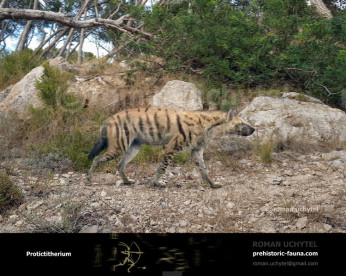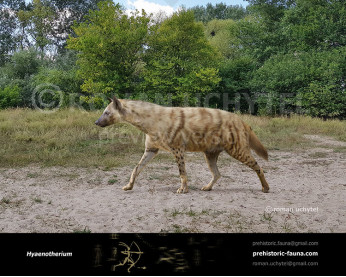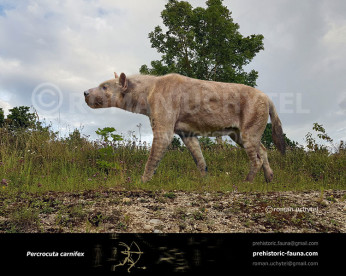Belbus djurabensis
207207Belbus (Belbus Werdelin, Solounias, 1991)
Order: Carnivora
Family: Percrocutidae
Time period: the late Miocene of Eurasia (11.8 – 11.2 mln years ago)
Size: 1.3 m in length, 60 cm in height, 55 kg of weight.
Typical representative: Belbus beaumonti Qiu, 1987
The order Carnivora constitutes a distinct monophyletic cohort, and its division into two branches of Feliformia and Caniformia is considered commonly-acknowledged. However, detailed examination of the auditory region of its skull (ontogenesis of auditory bubbles, arterial circulation in the skull) revealed that some groups can philogenetically be recognized as a separate taxonomical unit, such as for instance in the case of Nimravidae and Barbourofelidae families, earlier classified as Feliformia. This is also related to Percrocutidae convergently similar to Hyaenidae which however were specialized carrion-eating carnivores already at the time when Hyaenidae family species were still small- to medium-size animals occupying the environmental niche of modern jackals and wolves. Belbus is a side line of Percrocutidae demonstrating mixed features of a carnivore with preference for utilization of dead animal corpses or remains of other carnivores’ feast alongside a considerable share of fresh meat of Hipparions and gazelle-like antelopes which lived in the same period.
Percrocutidae are Miocene carnivores whose evolution was distinguished by the strengthening of bone-fracturing adaptations. Such adaptations allowed them to quickly assume the position of active carnivores in the steppe landscapes of Southern Europe, Western and Central Asia, as well as China and Northern Africa.
Nevertheless, occupying the top of food chain as giant species in steppe landscapes throughout the late Miocene, by the end of the late Miocene, Percrocutidae surrendered their positions to the numerous Canidae, presumably mostly due to the more effective social organization of the latter.
Belbus (Belbus Werdelin, Solounias, 1991)
Order: Carnivora
Family: Percrocutidae
Time period: the late Miocene of Eurasia (11.8 – 11.2 mln years ago)
Size: 1.3 m in length, 60 cm in height, 55 kg of weight.
Typical representative: Belbus beaumonti Qiu, 1987
The order Carnivora constitutes a distinct monophyletic cohort, and its division into two branches of Feliformia and Caniformia is considered commonly-acknowledged. However, detailed examination of the auditory region of its skull (ontogenesis of auditory bubbles, arterial circulation in the skull) revealed that some groups can philogenetically be recognized as a separate taxonomical unit, such as for instance in the case of Nimravidae and Barbourofelidae families, earlier classified as Feliformia. This is also related to Percrocutidae convergently similar to Hyaenidae which however were specialized carrion-eating carnivores already at the time when Hyaenidae family species were still small- to medium-size animals occupying the environmental niche of modern jackals and wolves. Belbus is a side line of Percrocutidae demonstrating mixed features of a carnivore with preference for utilization of dead animal corpses or remains of other carnivores’ feast alongside a considerable share of fresh meat of Hipparions and gazelle-like antelopes which lived in the same period.
Percrocutidae are Miocene carnivores whose evolution was distinguished by the strengthening of bone-fracturing adaptations. Such adaptations allowed them to quickly assume the position of active carnivores in the steppe landscapes of Southern Europe, Western and Central Asia, as well as China and Northern Africa.
Nevertheless, occupying the top of food chain as giant species in steppe landscapes throughout the late Miocene, by the end of the late Miocene, Percrocutidae surrendered their positions to the numerous Canidae, presumably mostly due to the more effective social organization of the latter.

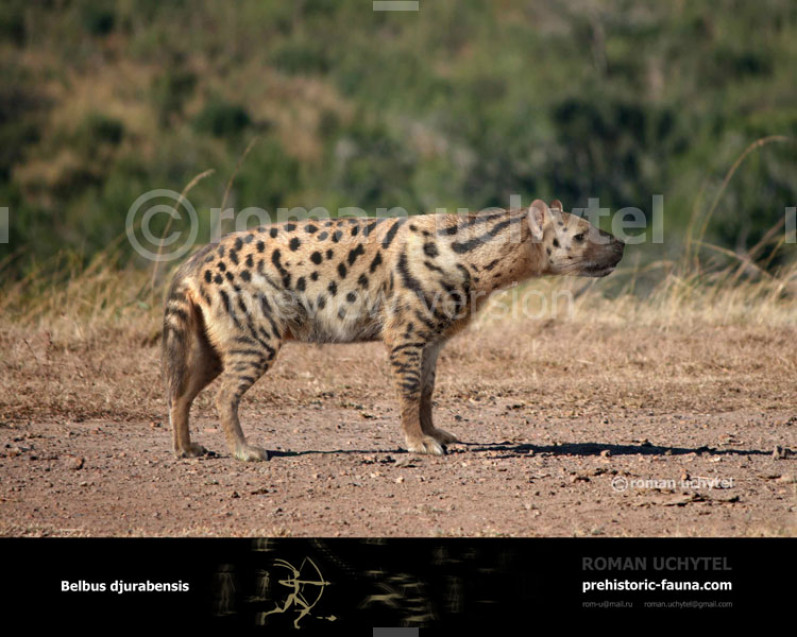
-346x277.jpg)
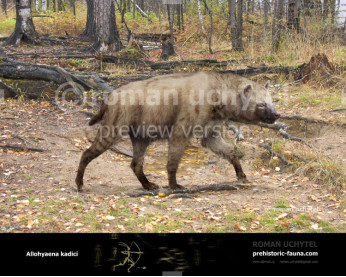
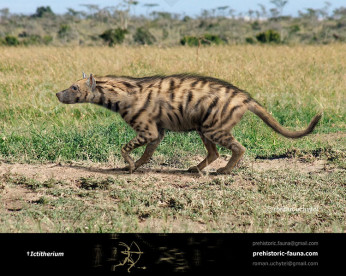
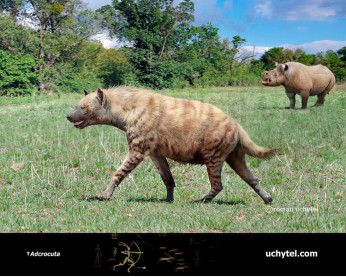
-346x277.jpg)
